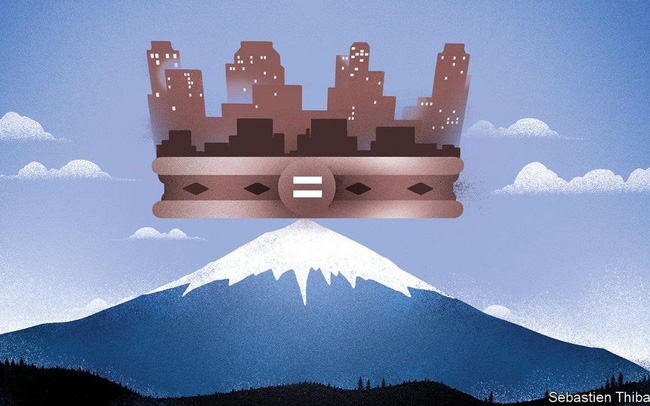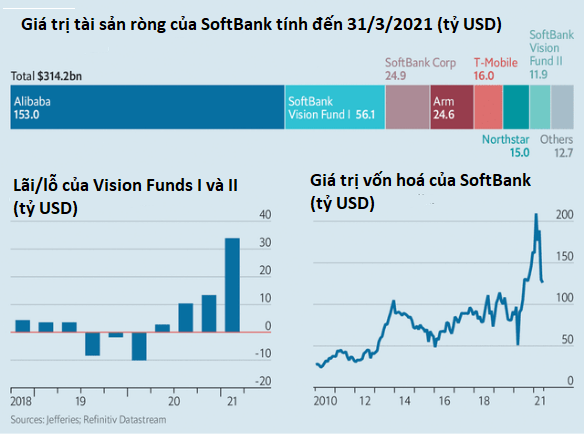Soft facts about SoftBank: How did Masa’s empire come back from the dead?
- Tram Ho
Every day, from 8 a.m. to 10 p.m., Masayoshi Son sits in his Tokyo mansion and entertains himself like no other: finding tech entrepreneurs and handing them money. Having to work from home because the pandemic has had little effect on SoftBank’s billionaire boss. At the meeting to announce business results on May 12, Son proudly shared that he had injected capital into 60 companies in the past 3 months. From January to March, he disbursed an average of $210 million per week. Over the past four years, SoftBank has poured a total of about $84 billion into startups.
Even before running the nearly $100 billion Vision Fund, it was the biggest investor in the tech world. The 224 companies backed by the Japanese conglomerate range from fledgling startups to giants like ByteDance, the owner of TikTok, a time-killing app popular with young people.
Names like Plenty, Better and Forward are on a mission to completely change industries like food, healthcare and banking. According to PitchBook, the total of companies funded by SoftBank has a valuation (according to SoftBank and other venture capital funds) at about $ 1.1 trillion.

Resurrected from the edge of the abyss
Last spring, it was not an exaggeration to say that the entire SoftBank empire was almost on the brink. With the Covid-19 pandemic raging and markets shaking, SoftBank lenders were really panicking. Yields on bonds issued by SoftBank soared.
Investors wonder how Son will manage during the epidemic storm. His “heavy eat” style became more risky than ever. WeWork’s IPO collapsed at the end of 2019, before the pandemic. From February to March 2020, SoftBank shares fell by more than 50%.
However, the market then recovered. The US Federal Reserve injects liquidity into the market by backing junk-rated corporate bonds like SoftBank. The group also announced the sale of assets worth 41 billion USD (out of total assets 252 billion USD) to resolve the problems.

Son is once again a genius. Investing in technology companies becomes the perfect strategy in a rapidly digitalizing economy. After only 1 year, SoftBank from trying to survive was able to print money massively like a giant ATM machine. The IPO of e-commerce company Coupang (Korea) brought in a profit of 24 billion USD. On June 10, Didi Chuxing (Chinese ride-hailing company in which SoftBank holds a 20% stake) said it intends to IPO with a valuation of about 100 billion USD.
Last month SoftBank reported a net profit of $46 billion, the highest ever for a Japanese company. Currently, SoftBank’s market capitalization is about $ 126 billion, an increase of $ 60 billion compared to March 2020.
SoftBank is still a strange company. Right before the “bumper”, the company recorded the largest loss in the history of Japanese businesses. SoftBank ignores all conventional standards of corporate governance. The group has also been embroiled in two of Europe’s biggest scandals in recent years: one involving the German payment company Wirecard and the other involving the British financial firm Greensill.
Founded by Son in 1981 with the initial business of distributing software, SoftBank began to enter the field of internet services in the 1990s, then moved into telecommunications. In 2006, it acquired the Japanese business of Vodafone (UK). In 2013, Son poured $20 into Alibaba, marking the most successful deal that brought him fame. This is also the deal that prompted Son to turn SoftBank into an investment company.
In 2018, Son sold off some assets in the telecommunications business in Japan and launched the Vision fund. One of the biggest deals was that with the help of Rejeev Misra, a former Deutsche Bank financier and an important son of Son, SoftBank raised $45 billion from the company’s public investment fund. Saudi Arabia and $15 billion from Abu Dhabi’s sovereign wealth fund.

Today SoftBank has four main pillars. The most valuable part is the 24.85% stake in Alibaba valued at $144 billion. The second part is the mobile phone business and chip company Arm. The 2 Vision funds form the third pillar. And finally Northstar, an insider hedge fund that was born a year ago. Son sits at the center of the grid.
Son has two big ideas to run SoftBank. The first is to combine investment in technology with financial engineering. To create high yields, he chooses traditional companies and “mixes” adding financial leverage and complex structures. Second, Son wants to create an interlaced “ecosystem” with SoftBank at the center. Although SoftBank typically owns only a handful of shares in companies, he still wants the companies in the network to work closely together. This model is quite similar to keiretsu such as Japanese super corporation Mitsubishi.
Too complicated
Let’s start with finance. At the highest levels of SoftBank, closest to Son, are a group of traders who worked at DeutscheBank when the German bank was famous for its willingness to take risks. At the top is Misra. “Complexity is their best friend – if they want to get from A to B, they’ll go around all the letters before reaching the finish line,” said one person who knows SoftBank well.
This is the path that led SoftBank to the Wirecard “squad”. In early 2019, WireCard stock price halved from its late 2018 peak after news of the accounting fraud broke. On March 28, 2019, Wirecard, then still a member of the DAX 30 index of blue-chip stocks in Germany, eloquently announced that it would sue the Financial Times after it published a series of articles investigating fraud by the Financial Times. the firm. Akshay Neta, a former trader who worked at Deutsche Bank and switched to SoftBank, chose to back Wirecard with all his fame.

On April 24, Wirecard announced that SoftBank had invested 900 million euros (equivalent to nearly 1 billion USD) through convertible bonds. The two sides also signed a cooperation agreement under which the German payments company can do business with other companies in SoftBank’s network. Immediately, Wirecard’s stock price skyrocketed 21%, the company’s reputation also increased rapidly.
However, this deal has 2 unusual points. Not long after the issuance, the aforementioned bonds were refinanced and brought in a profit of 64 million euros. When Wirecard collapsed in June 2020, only other investors lost.
Another oddity is that SoftBank doesn’t directly pour money into Wirecard. That is SBIA, the investment fund that oversees the Vision Fund under the group. SBIA’s investors include a small group of SoftBank executives looking to make their own profits, among them Naheta, Misra and Sago Katsunori, SoftBank’s former chief strategy officer. The Wirecard partnership initially posed a risk to SoftBank’s reputation given what the Financial Times reported, but ultimately the profits from the bond transaction went to individuals, not individuals. SoftBank and its shareholders.
Northstar is another example. The newest member of the SoftBank network seems at first glance the complete opposite of Son’s ambitions to support brand-new companies and his 300-year vision. Northstar specializes in short-term bets on listed stocks that anyone with a brokerage account can trade. One reason for this choice is that SoftBank needs to reinvest part of the $41 billion in proceeds from asset sales. Most companies keep excess cash in safe but tedious assets like government bonds. But that was not Son’s choice.
Naheta is the man behind this deal. Northstar used SoftBank’s excess cash to make reckless bets and use huge leverage. Last September investors discovered that Northstar’s bets were so large that the stock’s price was distorted. Not long after that, Northstar was exposed as a “Nasdaddy whale” and lost $5.6 billion in derivatives trades for the fiscal year ending March 2021.
Refer to The Economist
Source : Genk
